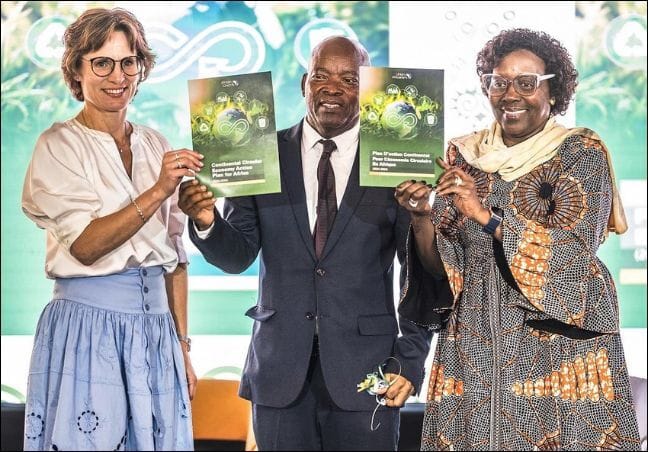- Circular Rising
- Posts
- Africa’s circular future takes shape with new continental action plan
Africa’s circular future takes shape with new continental action plan

From the newsletter
The transition to a circular economy took a major step forward with the launch of the Continental Circular Economy Action Plan (CEAP) for Africa 2024–2034. Unveiled jointly by the African Union and European Union, the plan provides a ten-year framework to advance sustainability, drive economic growth and improve resource efficiency across the continent.
Fragmented circular economy policies across African countries have slowed progress, creating regulatory uncertainty and inefficiencies that hinder investment, cross-border trade and the scaling of local circular initiatives.
The CEAP aims to address this by harmonising policies, mobilising financing and coordinating regional action, laying the groundwork for a more connected, investable and inclusive circular economy.
More details
Launched on the sidelines of the 20th African Ministerial Conference on the Environment (AMCEN-20) on 17 July 2025 in Nairobi, the CEAP 2024-2034 focuses on transitioning African economies to a circular model by reducing waste, promoting resource reuse and encouraging recycling.
As a key component of the African Union’s Agenda 2063, the CEAP prioritises strategic sectors including agriculture, packaging, energy, construction, manufacturing, electronics, technology and the fashion and textiles industries.
The plan is anchored around five core objectives that together aim to transform Africa’s development model through circularity. It promotes circular practices across key sectors by encouraging sustainable approaches in agriculture, industry and energy — transforming waste into resources and driving innovation in material use. Strengthening waste management is also central, with a focus on improving recycling infrastructure and integrating green technologies alongside local innovations.
Job creation lies at the heart of the plan, with an emphasis on generating green employment and supporting sustainable entrepreneurship, particularly for youth and women. The CEAP also seeks to deepen regional cooperation by aligning policies, sharing best practices and fostering cross-border collaboration for greater collective impact. Finally, it is positioned to build climate resilience by advancing sustainable production, reducing consumption and conserving biodiversity.
In a joint press statement, Moses Vilakati, AU Commissioner for Agriculture, Rural Development, Blue Economy and Sustainable Environment, said the plan “represents a unique opportunity for Africa to lead in the global circular economy and tackle the challenges of climate change head-on.” Adding to this, EU Commissioner for Environment, Water Resilience and a Competitive Circular Economy Jessika Roswall described it as “an opportunity to drive economic growth, create jobs and reduce environmental impact.”
Following the launch, both the AU and EU affirmed their commitment to CEAP implementation, offering financial assistance, technical expertise and capacity-building support. The AU is also seeking additional backing from international partners including development banks and the private sector.
The action plan’s launch marks a key moment in Africa’s circularity journey. For the first time, the continent has a common, strategic framework to guide its transition over the next decade. While several countries have made progress individually, with national policies, pilot projects and public-private partnerships, the lack of coordination has limited the scale and coherence of impact. The action plan seeks to change that by aligning efforts, unlocking investments and driving collective action.
At its core, the plan recognises that Africa’s waste and resource challenges transcend borders and sectors. Whether dealing with e-waste trade, textile recycling or food systems, many issues cannot be solved in isolation. The CEAP encourages a continental perspective, one that enables policy alignment, regional infrastructure and shared standards. This opens the door to cross-border solutions such as regional recycling hubs, harmonised packaging standards and integrated material tracking systems.
Economically, the CEAP presents a strong case for circularity as a growth and job creation strategy. By focusing on priority sectors like agriculture, construction, manufacturing and electronics, the plan supports local value addition and innovation. Instead of exporting raw waste or importing costly materials, African countries could build new industries around repair, reuse, remanufacturing and resource recovery. These sectors offer strong potential for job creation, especially for youth, women and small enterprises.
The plan’s emphasis on green technologies, entrepreneurship and climate resilience also signals a shift in development thinking. Circularity is no longer just an environmental concern – it is a lever for inclusive, climate-smart industrialisation. With backing from the EU and UNDP, the CEAP could catalyse large-scale investment and technical support, particularly if countries move swiftly to embed it into national plans.
However, the real test lies ahead. Turning ambition into action will demand not only political will and institutional capacity, but also a fundamental shift in mindset, from linear consumption to circular thinking. Governments must lead by creating enabling environments through supportive policies, incentives and investment in infrastructure. At the same time, the private sector needs to be engaged as both innovator and implementer, while civil society and informal actors, particularly waste pickers, must be meaningfully included in the transition.
If countries align policies, mobilise resources and empower local actors, the CEAP could become more than a plan, it could redefine Africa’s development model through circularity.
Our take
If implemented effectively, CEAP will not only reduce waste and environmental harm but also catalyse innovation, resilience and inclusive growth, turning circularity from a niche concept into a continental engine of transformation.
The CEAP could shift Africa’s development narrative – from being seen as a passive recipient of circular technologies to becoming a global innovator in low-cost, community-driven models tailored to the Global South.
With Africa’s urban population set to double by 2050, this plan arrives just in time. Cities should be prioritised as hubs for piloting scalable circular infrastructure and local policy innovation.